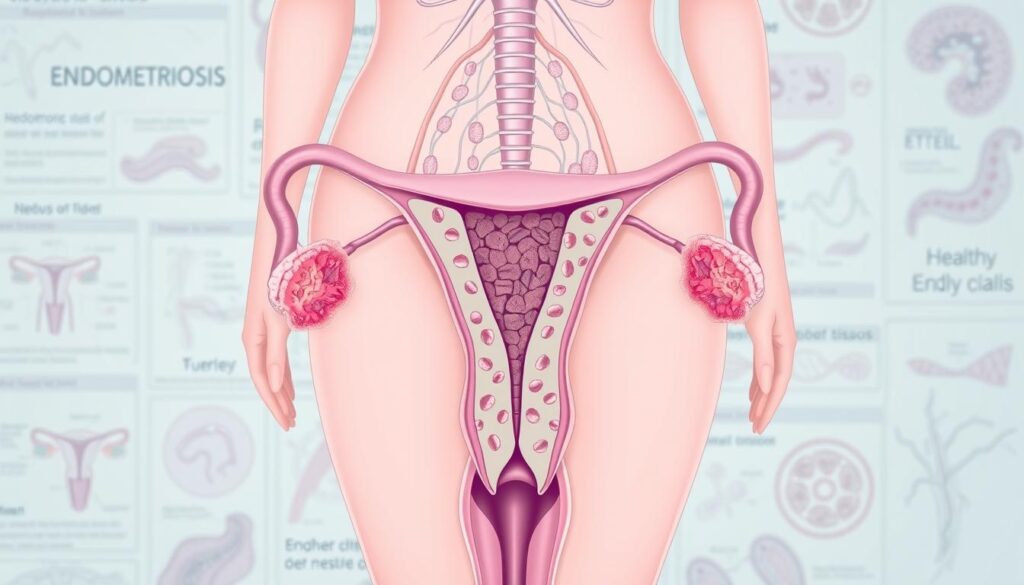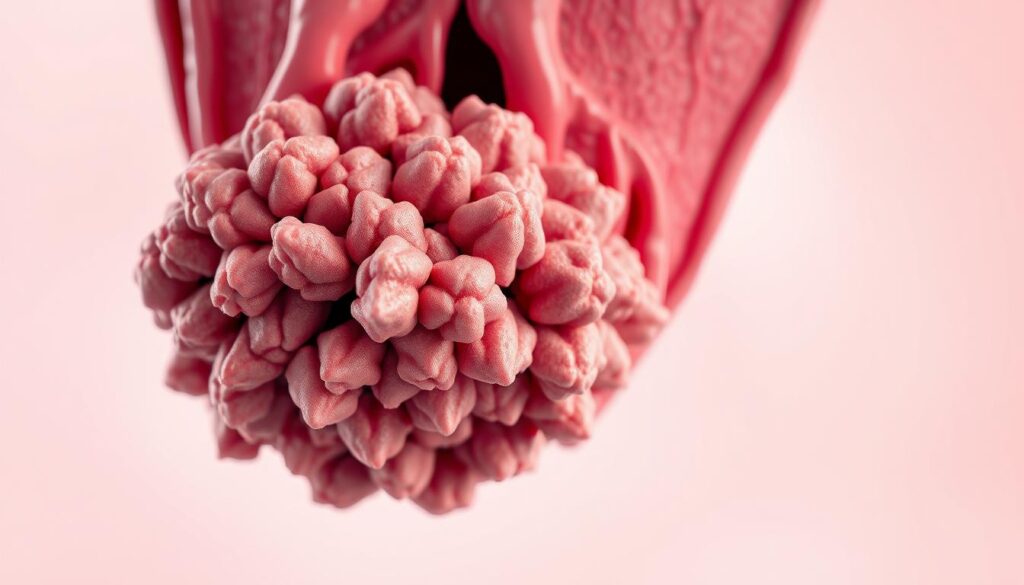Endometriosis is a serious condition that affects about 176 million women worldwide. Yet, it’s often misunderstood and not diagnosed enough. This guide explores the details of endometriosis, its effects on women’s health, and new ways to diagnose and treat it. We hope to help those affected and increase understanding of this hidden challenge.

Key Takeaways
- Endometriosis is a chronic and often painful condition where the endometrial tissue grows outside the uterus
- It can lead to a range of symptoms, including pelvic pain, heavy bleeding, and infertility
- Raising awareness and fostering support are key to empowering those affected by this condition
- Ongoing research is exploring new ways to improve the understanding and management of endometriosis diseases
What is Endometriosis and Its Impact on Women’s Health
Endometriosis is a chronic, painful condition. It happens when tissue like the uterine lining grows outside the uterus. This tissue grows on other organs in the pelvic area.
This growth can cause inflammation, scarring, and adhesions. These can lead to a lot of discomfort and health issues for women.
The Biology Behind Endometrial Tissue Growth
Normally, the uterine lining thickens, breaks down, and sheds during the menstrual cycle. But in endometriosis, this tissue grows and bleeds too. It gets trapped instead of leaving the body.
This leads to symptoms like pain, heavy bleeding, and inflammation.
Common Locations of Endometrial Lesions
Endometriosis often affects the ovaries, fallopian tubes, and the pelvis lining. But it can also appear in the bladder, intestines, and even the diaphragm. Where the lesions are can affect how bad the symptoms are.
Understanding Disease Progression
Endometriosis gets worse over time if not treated. As the tissue grows and bleeds, it causes more scarring and adhesions. This can lead to more severe symptoms and long-term health problems.
“Endometriosis is a complex and debilitating condition that can have a significant impact on a woman’s physical, emotional, and social well-being. Understanding the underlying biology and progression of the disease is crucial for effective management and treatment.”
Historical Background and Medical Recognition
Endometriosis has been around for centuries, with the first mentions in the 17th century. Doctors noticed tissue like the uterine lining outside the uterus back then.
In the late 1800s, doctors started to really study endometriosis. Dr. Thomas Cullen and Dr. John Sampson were key in understanding it. They figured out its causes and how it affects women’s health.
But, for a long time, doctors didn’t fully get endometriosis. It was often not diagnosed right, leading to delays in treatment. It wasn’t until the 1990s that it was seen as a serious health issue. More research and awareness helped then.
Now, endometriosis is known as a chronic condition that affects many women. It can cause menstrual cramps and fertility issues. Thanks to ongoing research, doctors now know how to better diagnose and treat it.
“Endometriosis is a condition in which tissue similar to the lining of the uterus (the endometrium) is found in other parts of the body. This misplaced tissue behaves in the same way as the uterine lining, thickening, breaking down, and bleeding with each menstrual cycle.”
The medical world’s growing understanding of endometriosis has greatly helped women. It’s a big step towards better lives for those with this complex condition.
Common Symptoms and Warning Signs
Endometriosis can cause a range of symptoms, from mild to severe pain. It’s important to know the early signs and how severe they can be. This helps in getting medical help quickly.
Identifying Early Warning Signs
The first signs of endometriosis often include:
- Pelvic pain before and during menstruation
- Excessive or prolonged menstrual bleeding
- Painful intercourse
- Chronic lower back pain
- Fatigue and lack of energy
Severity Levels of Symptoms
The severity of endometriosis symptoms varies. Some people might feel mild discomfort, while others face severe pain. The severity often shows how deep the disease has spread.
When to Seek Medical Attention
If you have persistent or worsening pelvic pain, or abnormal bleeding, see a doctor. Early treatment can help manage symptoms and prevent complications. Don’t delay in talking to a healthcare professional for the right care.
Understanding Endometriosis Diseases: Types and Classifications
Endometriosis is a complex condition with many forms. It’s important to know the different types and classifications. This will give us a deeper understanding of how endometrial tissue grows.
Superficial Endometriosis
Superficial endometriosis is the most common type. It involves endometrial-like tissue on the surface of pelvic organs. These lesions are shallow and can cause discomfort and adhesions.
Deep Infiltrating Endometriosis
Deep infiltrating endometriosis is different. It involves endometrial tissue growing deep into pelvic organs. This can lead to severe symptoms and complications.
Ovarian Endometriomas
Endometriomas, or “chocolate cysts,” occur in the ovaries. They can be large and painful. They may also affect fertility and reproductive health.
Knowing the different types of endometriosis is key for diagnosis and treatment. It helps healthcare providers tailor care to each patient. This improves outcomes and quality of life for those with endometriosis diseases.

Risk Factors and Genetic Predisposition
It’s important to know the risk factors for endometriosis to prevent and manage it. The exact causes are still a mystery, but research has found several key factors. These factors help us understand how endometriosis develops and grows.
Hereditary Factors
Studies show that endometriosis often runs in families. Women with a first-degree relative who has it are 5-7 times more likely to get it. This highlights the role of family history in assessing risk.
Environmental Risk Factors
Exposure to certain chemicals and toxins can raise the risk of endometriosis. Dioxins, phthalates, and other endocrine-disrupting compounds can affect hormone balance. This can lead to the development and worsening of the disease.
Lifestyle Contributors
- Being overweight or obese may increase the risk of endometriosis. This is likely due to the impact on hormone levels.
- A diet high in trans fats and red meat may raise the risk. On the other hand, a diet rich in vegetables, fruits, and whole grains may help protect against it.
- Chronic stress and high anxiety can also increase the risk. They can disrupt the body’s hormonal balance.
Knowing these risk factors helps us take steps to prevent endometriosis diseases. It also helps in addressing the underlying factors that contribute to its onset and progression. This can lead to better infertility outcomes.
Diagnostic Procedures and Testing Methods
Getting a correct endometriosis diagnosis is key for good treatment. Doctors use many tests to find out if someone has endometriosis and how bad it is.
Laparoscopic surgery is a big help. It’s a small surgery where a camera is used to see inside the belly. This way, doctors can see the endometrial lesions and even remove them. It helps with both finding out what’s wrong and fixing it.
- Ultrasound and MRI can show where the endometrial implants are. But, they might miss some small or deep ones.
- Blood tests, like the CA-125 test, can give clues. But, they’re not enough on their own to say for sure.
- A pelvic exam is also important. It helps doctors find signs that might mean someone has endometriosis.
Getting the right diagnosis is very important. It helps doctors give the right treatment and care for endometriosis. By using different tests, doctors can really understand what’s going on with each patient. Then, they can make a treatment plan that fits just right.
“Early and accurate diagnosis is essential for effectively managing endometriosis and minimizing its impact on a woman’s health and quality of life.”
Importance of Accurate Diagnosis
It’s very important to diagnose endometriosis quickly and correctly. This lets doctors make a treatment plan that’s just right for each person. They can keep an eye on how the disease is doing and help symptoms early on.
Doctors can make a plan to manage pain and use hormone therapy. If needed, they might do laparoscopic surgery to remove the bad tissue. This helps make symptoms better and can stop problems from getting worse.
Medical Treatment Options Available
Endometriosis is a complex condition needing a variety of treatments. Luckily, there are many medical options to manage symptoms and slow the disease’s growth. These include hormone therapy, pain management, and surgery.
Hormone Therapy Approaches
Hormone therapy is a key treatment for endometriosis. These medicines control hormones that cause endometrial tissue growth. Common treatments include birth control pills, progestins, and GnRH agonists.
These treatments help reduce pain, shrink endometrial lesions, and stop new ones from forming.
Pain Management Strategies
Healthcare providers also suggest pain management strategies. This can include pain medicines like NSAIDs or opioids. Other options include physical therapy, acupuncture, or using heat and cold compresses.
Surgical Interventions
For some, surgery is needed. Procedures like laparoscopy, hysterectomy, or excision surgery can remove or destroy lesions. Surgery is considered when other treatments fail or the disease is severe.
It’s crucial to work with your healthcare provider to find the best treatment for you. The right mix of therapies depends on your endometriosis severity, personal preferences, and health goals.
| Treatment Approach | Mechanism of Action | Potential Benefits |
|---|---|---|
| Hormone Therapy | Regulate hormones that contribute to endometrial tissue growth | Alleviate pain, reduce lesion size, prevent new lesions |
| Pain Management | Utilize medications, physical therapy, and complementary therapies | Address discomfort and improve quality of life |
| Surgical Interventions | Remove or destroy endometrial lesions through procedures | Alleviate severe symptoms and complications |
“Endometriosis is a complex condition that requires a personalized approach to treatment. By working closely with your healthcare provider, you can explore the various medical options and find the right combination to manage your symptoms and improve your overall well-being.”
Natural and Alternative Treatment Approaches
Looking for ways to manage endometriosis and pelvic pain without medication? There are many natural and alternative treatments out there. These options can be great additions to your treatment plan, but always talk to a doctor first.
Herbs and dietary supplements are popular choices. Research shows that turmeric, ginger, and green tea might help with inflammation. Omega-3 fatty acids, vitamin B1, and magnesium could also offer relief.
Complementary therapies like acupuncture, massage, and yoga are also worth trying. They focus on your overall well-being. This can help reduce stress and pain.
| Natural Remedy | Potential Benefits |
|---|---|
| Turmeric | Anti-inflammatory properties |
| Omega-3 Fatty Acids | Reduced inflammation and pain |
| Acupuncture | Improved pain management |
| Yoga | Stress reduction and improved well-being |
Remember, how well these treatments work can vary. Always check with a doctor before trying them. More research is needed to fully understand their benefits for endometriosis.

“Integrative approaches, when used responsibly and under the guidance of healthcare providers, can be valuable additions to the management of endometriosis.”
Managing Daily Life with Endometriosis
Living with endometriosis is tough, but you can manage it. With the right strategies and lifestyle changes, you can handle your symptoms better. This can improve your life quality a lot.
Coping Strategies
Pain management is key for those with endometriosis. Endometriosis symptoms like bad menstrual cramps can really hurt. But, there are ways to feel better.
Try over-the-counter pain meds, heat therapy, or yoga and meditation. Talking to your doctor about pain relief is also crucial. They can help find what works best for you.
Lifestyle Modifications
Changing your lifestyle can help a lot with endometriosis. Here are some tips to lessen menstrual cramps and other symptoms:
- Eat a healthy diet full of fruits, veggies, and whole grains.
- Do low-impact exercises like walking, swimming, or stretching.
- Use stress management like mindfulness, deep breathing, or counseling.
- Get enough sleep to help your body heal.
By using these strategies and making lifestyle changes, you can take charge of your endometriosis. This can greatly improve your health and well-being.
“Managing endometriosis is a journey, but with the right support and self-care, it’s possible to thrive despite the challenges.”
Impact on Fertility and Pregnancy
Endometriosis is a complex condition that affects a woman’s fertility and pregnancy. It’s a chronic disease where endometrial-like tissue grows outside the uterus. This can disrupt reproductive functions and lead to fertility challenges.
Endometriosis can distort and scar the pelvic anatomy. The misplaced tissue can stick to ovaries, fallopian tubes, or other organs. This makes it hard for the egg to be fertilized or for the embryo to implant in the uterus.
The inflammation caused by endometriosis can also make it hard for an embryo to implant. Women with endometriosis may have irregular periods, heavy bleeding, and pain. These symptoms can lower their fertility.
Fertility Preservation Options
For those with endometriosis who want to have children, there are fertility preservation options. These include:
- In vitro fertilization (IVF) to overcome infertility challenges
- Egg or embryo freezing for future use
- Assisted reproductive technologies, such as intrauterine insemination (IUI)
Even with endometriosis, many women can conceive and carry a healthy pregnancy. Medical interventions and support are key to success.
| Fertility Rates in Women with Endometriosis | Fertility Rates in Women without Endometriosis |
|---|---|
| 50-60% | 80-90% |
Women with endometriosis should work closely with their healthcare providers. Understanding their fertility status and exploring options can empower them to make informed decisions about their reproductive health.
Latest Research and Medical Advances
Researchers and doctors are always finding new ways to treat endometriosis. They are focusing on endometriosis treatment and laparoscopic surgery as key areas of study.
Emerging Treatment Options
One big step forward is the creation of targeted drug therapies. These drugs aim to fix hormonal imbalances and stop endometrial lesions from growing. This could help patients feel better and manage their symptoms more effectively.
Doctors are also looking into anti-inflammatory drugs and new pain relief methods. These could make life easier for people with endometriosis.
Clinical Trials and Studies
Clinical trials are checking if laparoscopic surgery works well for endometriosis. This surgery is less invasive and might help remove endometrial implants and adhesions. It could also lower the chance of the disease coming back.
Researchers are also studying how these surgeries affect fertility and reproductive health. This could lead to better treatments in the future.
As scientists learn more about endometriosis, there’s hope for better treatments. Patients might see improvements in diagnosis, treatment, and understanding of the disease.
Support Systems and Resources
Living with endometriosis can feel tough and isolating. But, you’re not alone. Many support systems and resources are here to help you through this chronic disease.
Connect with Support Groups
Joining a support group, online or in person, is a great way to get emotional support and advice. These groups have meetings, workshops, and events. You can share your story, learn from others, and know you’re not alone.
- Endometriosis Association: Offers support groups, educational resources, and advocacy initiatives.
- Endometriosis Foundation of America: Provides support services, patient education, and research funding.
- Pelvic Pain Support Network: Connects individuals with pelvic pain conditions, including endometriosis.
Explore Online Resources
The internet is a treasure trove of info and support for those with endometriosis diseases. Many organizations and advocacy groups have websites with educational materials, treatment options, and personal stories.
- Endometriosis.org: Offers detailed information on the condition, treatment approaches, and research updates.
- EndometriosisUK: Provides a range of resources, including a symptom checker and self-care tips.
- Endometriosis News: Covers the latest news, research, and patient perspectives on pelvic pain and endometriosis.
| Organization | Focus | Website |
|---|---|---|
| Endometriosis Association | Support, education, advocacy | endometriosisassn.org |
| Endometriosis Foundation of America | Research, patient support, awareness | endofound.org |
| Pelvic Pain Support Network | Connecting patients with pelvic pain conditions | pelvicpain.org.uk |
Remember, you’re not alone in your fight with endometriosis diseases. Use these support systems and resources to find the help, guidance, and community you need. They can help you manage your condition and improve your well-being.

Prevention Strategies and Risk Reduction
Endometriosis can’t be fully prevented, but there are ways to lower the risk. Knowing these strategies helps women take care of their reproductive health. It’s about being proactive.
Keeping a healthy lifestyle is key. Endometriosis symptoms and menstrual cramps can get worse with too much weight, bad food choices, and not moving enough. Eating well, exercising often, and staying at a healthy weight can help.
Getting help early and getting diagnosed fast is also important. Knowing the signs and acting quickly can lead to better treatment. Regular doctor visits can catch problems early.
- Maintain a healthy lifestyle: Adopt a balanced diet, engage in regular exercise, and maintain a healthy body weight.
- Be aware of early warning signs: Familiarize yourself with the common endometriosis symptoms, such as severe menstrual cramps, and seek medical attention if any concerns arise.
- Undergo regular check-ups: Schedule routine appointments with a healthcare provider to monitor your reproductive health and detect any potential issues early on.
While we can’t prevent endometriosis completely, these steps can help. By focusing on health and getting medical help when needed, women can manage endometriosis better. This improves their overall health and well-being.
Conclusion
Endometriosis is a complex condition that affects millions of women worldwide. We’ve looked into the details of endometriosis diseases, including their biology, symptoms, and treatment options.
Early diagnosis and proper management are key to dealing with endometriosis. Raising awareness and encouraging people to seek medical help is important. This way, those affected can get the care and support they need.
Research is helping us understand endometriosis better and find new treatments. By staying updated, individuals can work with their healthcare providers. This helps them make informed decisions about their care and wellness journey.
FAQ
Q: What is endometriosis?
A: Endometriosis is a chronic condition where tissue like the uterus lining grows outside the uterus. It usually grows on other organs in the pelvic area. This tissue acts like the uterine lining, thickening, breaking down, and bleeding with each menstrual cycle.
Q: What are the common symptoms of endometriosis?
A: Symptoms include painful periods, heavy or irregular bleeding, and chronic pelvic pain. Other symptoms are pain during intercourse, fatigue, and infertility. The severity of symptoms varies from person to person.
Q: How is endometriosis diagnosed?
A: Doctors use a mix of medical history, physical exam, and imaging tests like ultrasound or MRI. Sometimes, laparoscopic surgery is needed for a definitive diagnosis.
Q: What are the treatment options for endometriosis?
A: Treatments include pain medication, hormone therapy, and surgery like laparoscopic excision. The best treatment depends on symptoms, disease extent, and fertility goals.
Q: How does endometriosis affect fertility?
A: It can cause scarring, distort pelvic anatomy, and lead to inflammation. These issues can affect egg release, implantation, and embryo development. Yet, many women with endometriosis can still conceive with proper care.
Q: Are there any natural or alternative treatments for endometriosis?
A: Some women try natural or alternative treatments like dietary changes, herbal remedies, and acupuncture. Always talk to a healthcare provider before starting any new treatments.
Q: How can I manage daily life with endometriosis?
A: Managing daily life includes pain management, lifestyle changes, and talking openly about your experiences. Techniques like heat therapy or over-the-counter medications can help. Regular exercise and stress management are also important.
Q: What are the latest research and advancements in endometriosis treatment?
A: Researchers are looking into new treatments, including drugs and surgical techniques. They’re also exploring personalized care. Clinical trials are ongoing, aiming to improve treatment options in the future.
Q: Where can I find support and resources for endometriosis?
A: Support is available through organizations, online communities, and educational resources. These offer valuable information, peer support, and connections to specialists.
